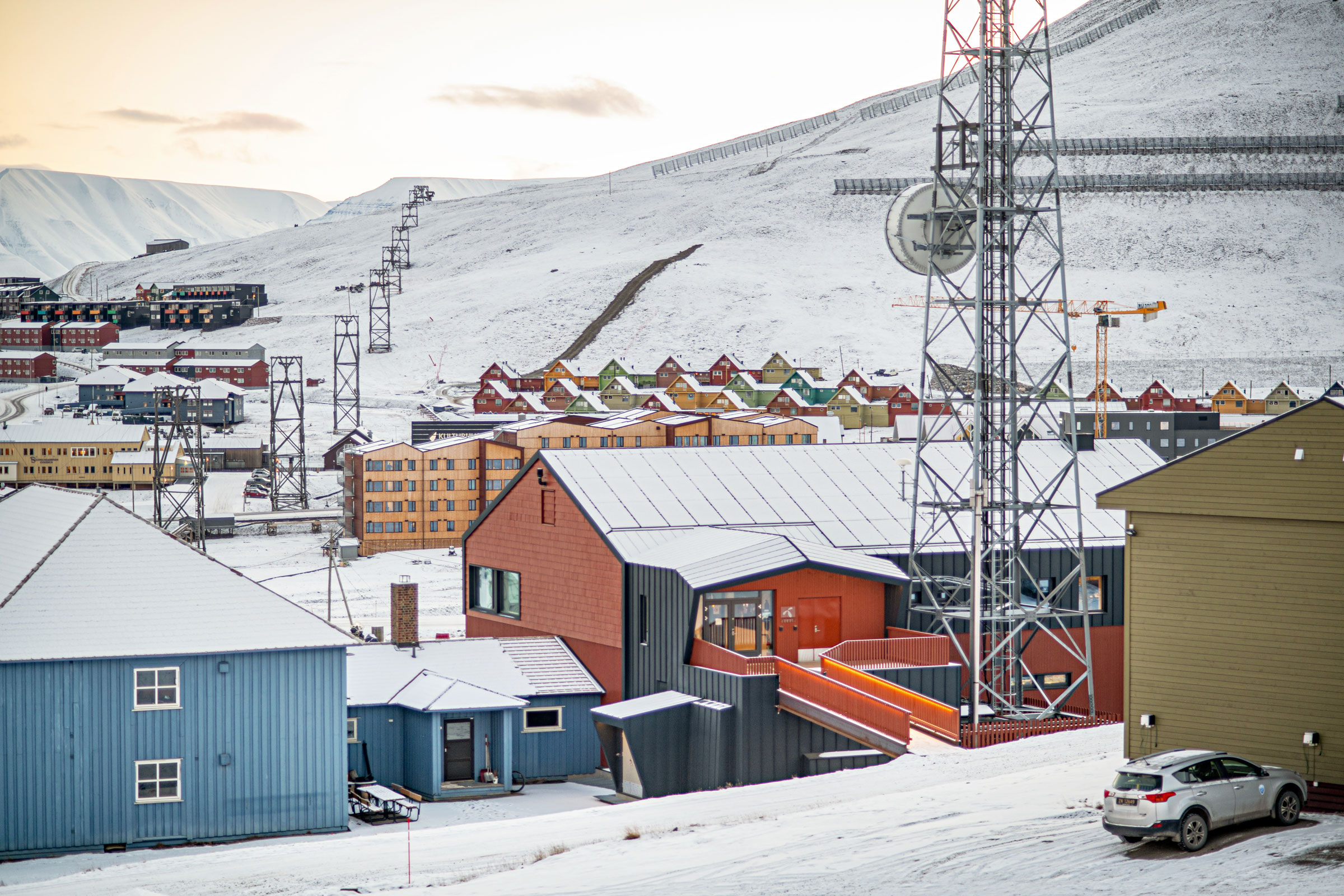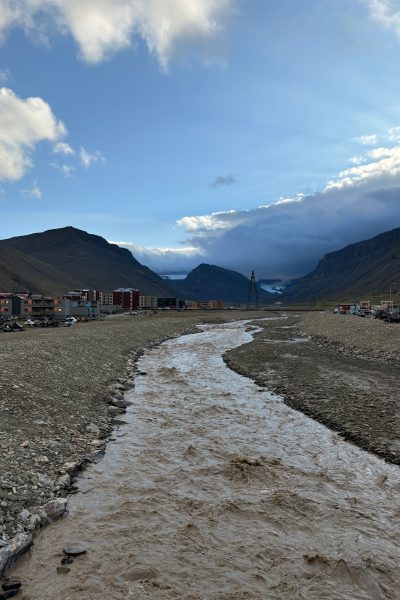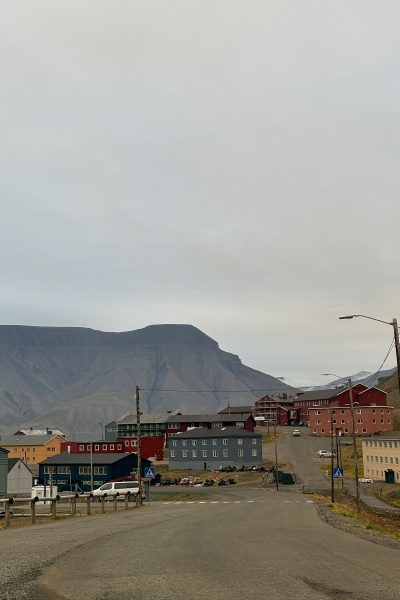Story at a glance:
- The Arctic archipelago of Svalbard offers an up close look at the real and devastating effects of climate change.
- gb&d traveled to the land of Northern Lights and midnight sun to see just how quickly things are changing—and how sustainable strategies are being considered to protect vulnerable communities.
- Read more about Svalbard at these links: Explore the paradox of sustainable tourism, tour a remote adventure hotel harnessing the sun, designing for the future with the Global Seed Vault, and see how the world’s northernmost brewery commits to the environment.
The people of Svalbard are bracing for the next avalanche.
The Norwegian islands near the North Pole are home to roughly 2,500 people—most of them living in a vibrant settlement called Longyearbyen in the valley. But with unprecedented climate disasters—including two devastating avalanches in 2015 and 2017—there is cause for worry.
“A lot of my friends who lived here during those avalanches, they just moved out because it was too scary for them to live here with their family. Some of them were digging the snow out of the houses, and to them the trauma was too big to stay here,” says Ingvild Sæbu Vatn, an architect who relocated to Svalbard from mainland Norway in 2011, in part to open the Longyearbyen office of LPO, an Oslo-based architecture firm.
The week before Christmas 2015 a strong storm triggered an avalanche, killing two people, including one child, and caused many injuries and destroyed 11 houses, according to an article from ScienceDirect. More than 200 people were evacuated. The region has repeatedly been called the most climate-sensitive in the world.
Another avalanche occurred under similar conditions in February 2017, striking apartments near those destroyed in 2015. Since then more measures—like snow fences—have been put into place and homes have been moved, but some say more needs to be done to protect both the people and the land.
We’ve put up a lot of fences. In a way it’s a physical manifestation of the threat.
“We’ve put up a lot of fences. In a way it’s a physical manifestation of the threat,” Vatn says. “Now we have triple fencing, triple security.” One fence is meant to collect any snow that barrels down the hill, while another aims to keep the snow in the hill. Both help prevent an avalanche from reaching the town’s third layer of protection—a large wall at the bottom of the mountain. While it’s added security, Vatn says these changes also reduce the available living area in an already small place. The historic settlement is located in a narrow river valley with beautiful views and incredible access to nature, but there is very little place for building. “The town is not allowed to expand on unbuilt land outside the existing footprint,” she says.
But it’s not just the avalanche risk that has increased since Vatn moved less than 15 years ago. She’s also seen receding glaciers and a decrease in animal population, as she and her partner can’t find as many seals to feed their dog-sledding dogs, a common practice on Svalbard. That’s also a problem for the polar bears. Different fish, though, have also shown up as the water warms.
We recently traveled to this northern land of fjords and glaciers—about 60% of Svalbard’s land is currently covered by glaciers—to learn just how quickly things are changing.
An Architect’s Perspective
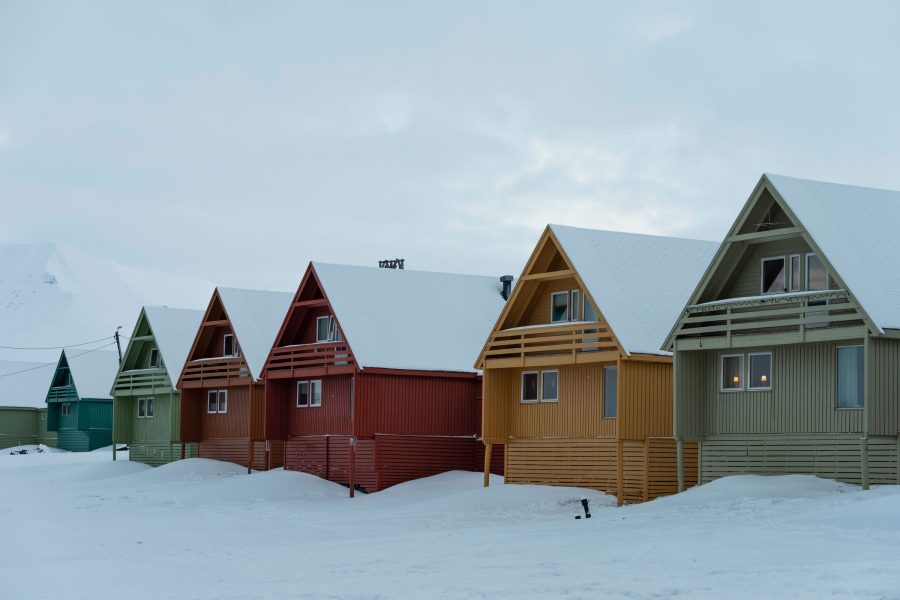
Some colorful houses in Longyearbyen on Svalbard have been at risk of damage by avalanche. Photo by Marie Nystad Helgesen
Unprecedented beauty, unprecedented ice melt, unprecedented rain, unprecedented pain. It’s a word I heard—and probably said myself—a lot during my brief time on Svalbard. Unprecedented pronunciations, too, for some people; for weeks when I mentioned my upcoming trip people asked me to repeat myself. “Can you spell it?” They asked. “Small bar?” I eventually just showed them on Google Maps.
While some people were unfamiliar, or even confused, others called it a trip of a lifetime. The latter is almost certainly true. I’ve long been enchanted by the stark landscapes of the glacier-laden places of the globe—Svalbard literally and figuratively high among them. It was a place I wanted to see before it was, well, possibly too late.
Warming Waters
- Photo by Laura Rote
- The settlement of Longyearbyen is pedestrian- and snowmobile-friendly. Photo by Laura Rote
Widespread studies, including research from a professor at Uppsala University who’s been studying the arctic ice since 1997, show Svalbard and the Barents Sea are the fastest warming region on the globe.
People living on Svalbard face a number of challenges. Architects especially are tasked with getting creative if they want to preserve this rare place that so many, like LPO architect Ingvild Sæbu Vatn, love. Vatn’s own identity became intertwined with the island quickly after she made it her permanent home in 2011. She tried living in other places—like Trondheim and Oslo. “I don’t know who I am if I’m not on Svalbard,” she says.
Vatn says a lack of local materials and the effects of very fast global warming—including the melting of permafrost on Svalbard, erosion, avalanches, and the destabilization of building foundations—are troubling for the community. Plus, those who want to live more sustainably are at odds with the prevailing practices, and she says a legal framework makes it difficult to reuse materials and whole buildings.
Taking Action
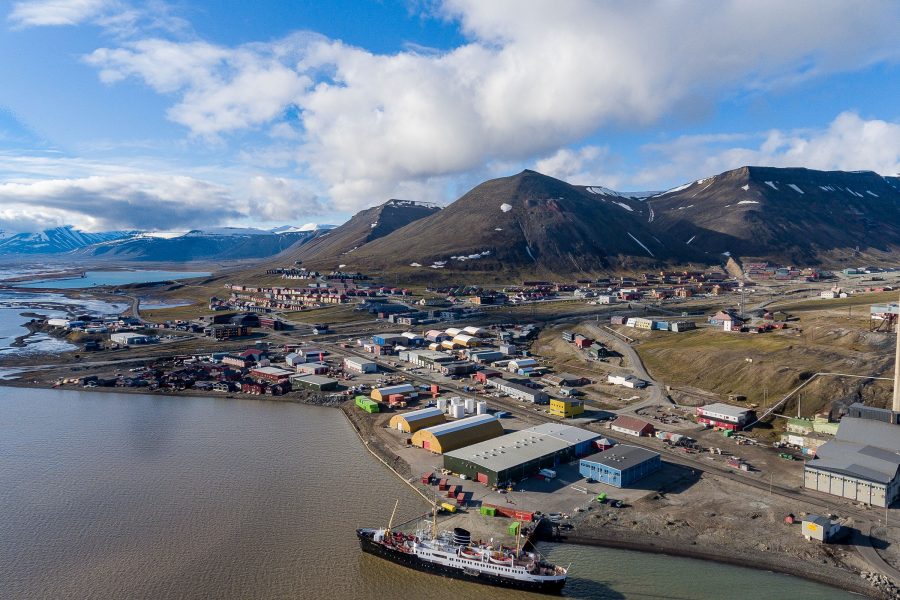
Photo courtesy of Visit Svalbard
Architects at LPO led a feasibility study called Right Place – Right Form to look at buildings as a local resource and consider material banks in a future-oriented development of Longyearbyen (the main settlement on Svalbard). Since 2019 they have shepherded reuse projects in collaboration with several other actors and grants from DOGA, which administers the Ministry of Foreign Affairs grant program for architecture and design in Norway. The program aims to move people toward a more circular construction industry.
“Right Place – Right Form was a project trying to reuse as much as possible of the buildings and materials in an immediate approach to the development of the city. It didn’t matter what kind of a building or function; we tried to make a project where we could move buildings from Svea to Longyearbyen to reuse them here for new purpose or also move buildings within Longyearbyen. The project was not only about physical projects but also about creating awareness and local ownership within the community and showcase for a more sustainable building practice,” Vatn says.
There are histories in these materials and buildings.
While reusing materials is nothing new, she says some laws and regulations make it difficult in Longyearbyen and mainland Norway. LPO is looking at how they and others can limit the amount of resources both produced and transported back and forth to the island, especially as 40% of the world’s greenhouse gas emissions come from the built environment, and transport of machines and materials to construction sites accounts for 25% of heavy transport in Norway, according to LPO.
Vatn says reusing Svalbard’s own materials and buildings is also important to the region’s storytelling and identity. “There are histories in these materials and buildings.”
Past Meets Future
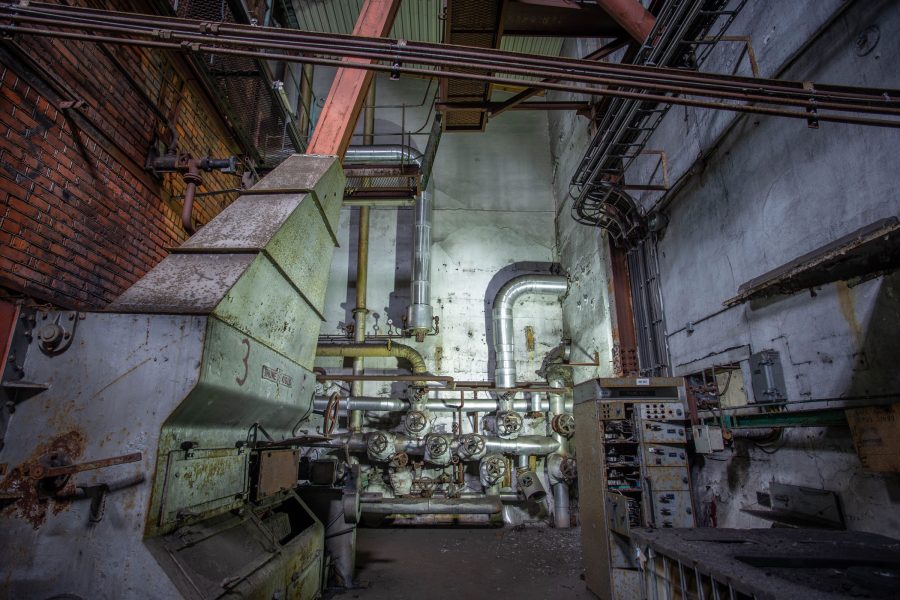
FOSSIL seeks to preserve and bring new life to a former power station that closed in the 1980s. LPO and others are working to make it an artistic attraction and cultural arena. Photo courtesy of LPO Architects

The exterior of FOSSIL, a former power station in Longyearbyen on Svalbard that closed in the early 1980s. Photo courtesy of LPO Architects
LPO initiated an effort to reimagine an old coal-fired power plant in Longyearbyen as an industrial monument, opening it up as an accessible, artistic attraction and cultural arena for the public on Svalbard. The FOSSIL project seeks to preserve and bring a new and different life to the power station, which has stood virtually untouched since its closure in the early 1980s. The project is a collaboration between LPO, the local council in Longyearbyen, Riksantikvaren (the directorate of cultural heritage), and others, including those working in tourism. “We wanted to show what kind of activities and cultural things and beautiful spaces we could use this building for,” Vatn says.
Longyearbyen has a long history as a coal mining town, dating back to 1906 when John Munro Longyear—the settlement’s namesake—started the industry. All but one mine in remote Svalbard has ceased operations, and Gruve (mine) 7 was set to cease production by summer 2025 as part of the area’s ongoing effort to reduce carbon dioxide emissions.
“It’s very difficult,” Vatn says. “The coal we have been using until now produces a high percentage of CO2. We were like the dirtiest people in the whole of Norway because our CO2 is so large per person. But the coal is here in Longyearbyen, so the coal extraction is already taking place.” While she describes its removal on Svalbard as “wounds in the landscape,” she recognizes it both as a local resource and for its cultural significance. And compared to global CO2 emissions, what’s experienced on Svalbard she says is very small.
Still, she says the community must commit to finding more sustainable systems, though the challenges are significant. Vatn says windmills can harm the birds (a solution near Isfjord Radio Adventure Hotel, a 55-mile boat ride away, is being considered that is lower to the ground), and some view them as an eyesore, while solar panels can be difficult to work with in a place of sometimes total darkness.
Building for the Future
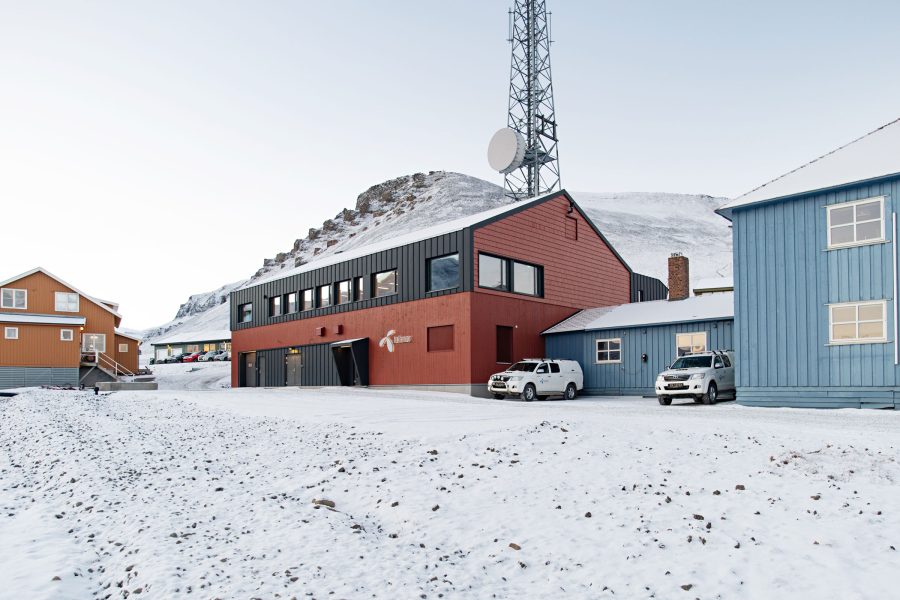
LPO designed a nearly zero-energy building for Norwegian telecommunications company Telenor, who is committed to reducing its climate footprint on Svalbard. Photo courtesy of LPO Architects
LPO recently designed an inspiring new administration building for Telenor, completed in 2022, in Longyearbyen. The Norwegian telecommunications company aims to become carbon neutral by 2030 and was committed to reducing its climate footprint on Svalbard. Today it’s almost a zero-energy building, with solar cells on the roof and heat recovery from the data center.
Material reuse was also a large focus of this project. The building’s wind bracing includes reused steel plates from a decommissioned mining operation elsewhere on Svalbard. Steel beams from the old building were transformed into footbridges, and parts of the external cladding were reused as siding in the gables of the new building.
“The building balances Telenor’s need for an energy-efficient and high-tech office building in the historically important building environment at Skjæringa (Longyearbyen’s oldest quarter) and is an important example for the future development of Longyearbyen,” Vatn says.
We can develop circular solutions in Longyearbyen that can also benefit so many other small settlements and local societies in the world.
Architects have a critical role in helping to save vulnerable places where people live, she says. Many houses on Svalbard will ultimately have to be rebuilt as many stand on wooden piles driven 20 or 30 feet into the permafrost—and that permafrost is melting. For homes on sloped terrain, that can be an even bigger problem, with rain and rotting piles.
“To make new foundations for the housing is quite expensive, so it is most cost-efficient just to tear the house down,” Vatn says, adding that there’s no use fitting it for the storms with extra insulation or new windows if the foundations are moving.
Heating is another problem, as cold air blows straight through many of the old buildings, Vatn says. “As long as we’ve had the coal power plant, which has a lot of extra heat energy, it hasn’t been a big problem. We can have houses with thin walls and wind blowing through them because we have the central heating system with a lot of the heat energy. But when we’re going over to new sources of energy, we’re probably not going to have that excess heat. We have to do something about insulation.”
Circular Solutions
Architects are uniquely positioned to help, Vatn says. “I think we have an understanding of the connections between people and built environment, people and landscape, and an ability to zoom in and out, abstract and conceptualize, that definitely can be used in the processes of developing, changing, and restoring places in vulnerable and harsh nature.”
LPO continues to look to circular strategies to help the community have a safer, more sustainable future. Strategies based on local needs and resources will also make the community less dependent on transporting goods from the mainland, less vulnerable for hostile actions on infrastructure, and less vulnerable to high prices on necessities while further bringing the community together, according to Vatn.
“We can develop circular solutions in Longyearbyen that can also benefit so many other small settlements and local societies in the world. We have huge human resources and knowledge in our international and transient little town.” LPO considers Svalbard the perfect test case for exploring circular solutions because of its small size. Take food waste, for example, that ultimately ends up in the sewer system, which goes into the fjord. That waste carries with it a lot of potential resources.
“We could first take the water out, and the water could be cleaned and used, if not as drinking water then as the water that goes into the toilet or other kinds of water. And you could use all that dry stuff you get out of it and make it into either biocoal or biogas (see how the local brewery is doing something similar). You could use it as a fertilizer, or you could use it to make heat or electricity,” Vatn says. “It’s quite a lot of resources we just put straight into the ocean. These kinds of circular systems would be so interesting to try to make work in this very small scale community.”

